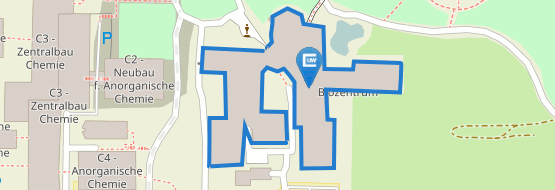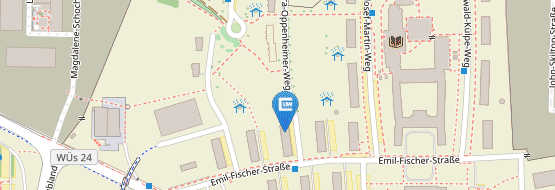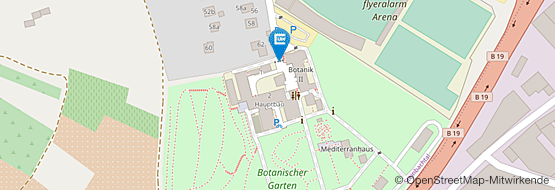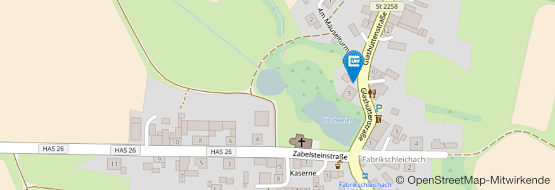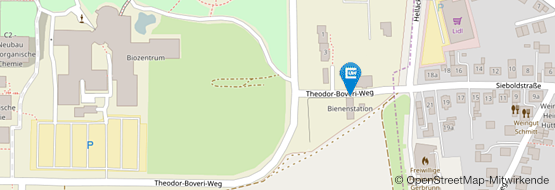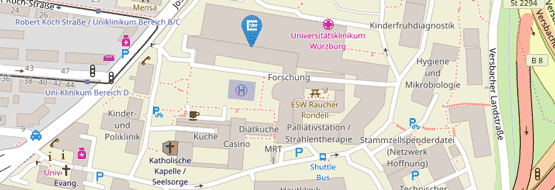Prof. Dr. Andrea Holzschuh
Prof. Dr. Andrea Holzschuh
Biocenter, University of Würzburg
Am Hubland

- Agroecology
- Landscape ecology
- Urban ecology
- Sport ecology
- Effects of land-use change and climate change on ecosystem services and crop yields
- Management actions that enhance crop pollination and natural pest regulation
- Synchronization of plant-pollinator-parasitoid interactions
2022 - 2025 FarmerBeeWild: Pollinator-friendly agricultural landscapes
Funding: Federal Ministry of Food and Agriculture / Bundesministeriums für Ernährung und Landwirtschaft (BMEL)
Projektträger: Federal Office for Agriculture and Food / Bundesantalt für Landwirtschaft und Ernährung (BLE)
Summary
Various agricultural policy instruments (e.g. greening) and compensation payments for environmentally-friendly management (e.g. KULAP) aim to counteract the decline in insects. However, their effectiveness in promoting pollinator diversity has hardly been studied and especially data on landscape level and on interactions between measures are lacking. The aim of this project is to (1) assess the pollinator situation of Bavaria's agricultural landscapes, (2) evaluate the success of current measures in promoting wild bees and pollination services, and (3) make recommendations on which combinations of practicable measures can be used to make agricultural landscapes more bee-friendly in the future.
Species groups: bees and other pollinators
Study regions: Bavaria (Germany)
Habitat: agricultural landscapes
2021 - 2025 SAFEGUARD: Safeguarding European wild pollinators
Funding: European Union's Horizon 2020 research and innovation programme
Webpage: https://www.safeguard.biozentrum.uni-wuerzburg.de
Summary
Safeguard aims to substantially contribute to reversing the loss of wild pollinators across Europe through increasing our understanding of the direct and indirect drivers of pollinator declines, environmental, economic and societal impacts and delivering an integrated assessment framework as basis for a portfolio of effective policy and practice solutions. Our goal is to inspire the development of management and policy guidelines for the public and private sectors to safeguard wild pollinators and the benefits they provide. Field studies on bees, hoverflies and butterflies will be conducted with a joint study design in 12 European countries.
Species groups: bees, hoverflies and butterflies
Study regions: Würzburg and Bayreuth (Germany) and 11 other European countries
Habitat: calcareous grasslands, agricultural and urban landscapes
2019 - 2027 Dorfbienen: Wildbienen in Dörfern
Förderer: Bayerisches Landesamt für Umwelt, Biodiversitätszentrum Rhön
Homepage: www.dorfbienen.biozentrum.uni-wuerzburg.de
Zusammenfassung:
Dörfer sind ein wichtiger Teil unserer Kulturlandschaft. Sie dienen als Wohnort, der Erholung und der Produktion von Obst und Gemüse, und bieten wertvolle Lebensräume für Insekten und Wirbeltiere. Für die ca. 550 Wildbienenarten in Deutschland liefern artenreiche Gärten, Obstbäume, Wildgehölze und strukturreiche Grünflächen ein vielfältiges Nahrungsangebot. Alte Holzscheunen, Obstbäume mit Totholz, Trockenmauern und offene Bodenflächen in Dörfern werden von vielen Wildbienen als Nistplätze genutzt. Mehr als die Hälfte der Wildbienenarten in Bayern sind durch das Verschwinden oder eine verminderte Qualität ihrer Lebensräume gefährdet. Zunehmender Nutzungsdruck, der Verlust von Kleinstrukturen und Flächenversiegelung, führen oft zu einer ökologischen Verarmung der Kulturlandschaft und damit dem Rückgang der Artenvielfalt im ländlichen Raum. Private Gärten und öffentliche Grünflächen sollen möglichst pflegeleicht und "ordentlich" sein, Unkräuter und Schädlinge werden ohne ökonomischen Zwang mit Pestiziden bekämpft und Flächen werden zur Minimierung des Pflegeaufwandes versiegelt. So sind in vielen Dörfern in den letzten Jahrzehnten vielfältige Lebensräume verloren gegangen. Dörfer besitzen ein großes Potential für die Förderung von Wildbienen und anderen Insekten. Im Dorfbienenprojekt untersuchen wir welchen Wert verschiedene Lebensräume in Dörfern für die Erhaltung der Artenvielfalt besitzen und wie die Vernetzung mit der umgebenden Landschaft die Vielfalt von Wildbienen beeinflusst. Ziel ist, gemeinsam mit den Gemeinden blütenreiche und vielfältige Lebensräume zu fördern und zum Schutz einheimischer Wildbienen und anderer Insekten beizutragen.
Projektziele: (1) Erfassung der Artenvielfalt von Wildbienen in Dörfern; (2) Erfassung der Blütenpflanzen und Nistplatzstrukturen; (3) Bewertung der Landschaftsvernetzung; (4) Entwicklung von Managementmaßnahmen in Dörfern; (5) Fördern des Wissenstransfers in die Gesellschaft
Artengruppen: Wildbienen und andere Bestäuber
Untersuchungsgebiete: Rhön und Mainfranken
Habitat: Dörfer und umgebende Agrarlandschaft
Methods: Feldaufnahmen und Bestäubungsexperimente, Landschaftsökologie
2015 - 2018 Enhancing biodiversity-based ecosystem services to crops through optimized densities of green infrastructure in agricultural landscapes ECODEAL (Biodiversa/BMBF)
Project summary:
Ecological intensification relies on ecosystem services to substitute external inputs in agriculture and has been proposed as a way to achieve high yielding, stable and sustainable crop production, while allowing to reach other societal targets such as nature conservation or human health. Pollination and natural pest control are key ecosystem services that can reduce pesticide use and increase crop yield quantity and quality. Organisms delivering these services depend to a large extent on non-crop habitats, or "green infrastructure" in the landscape, as cropland is not well suited as a habitat all year round. The project aims to answer the following questions: How much green infrastructure do we need to maintain stable communities of ecosystem service providers, and a high flow and stability of the services to the crop? Which type or combination of green infrastructure, old or young flower areas, arable fallows, seminatural grasslands, optimizes farmland biodiversity and ecosystem services? Since establishing non-crop habitat comes at a cost, which densities of green infrastructure will enhance crop yield and populations of service (or conservation) relevant species while providing net increases in crop productivity as well as net economic benefits to the farmer? ECODEAL will answer these questions.
Species groups: agricultural pests, pest control-related organisms incl. birds, pollinators
Study regions: Würzburg (Germany) and other European countries
Habitat: Agroecosystems
Methods: applied landscape ecology, GIS, yield measurements in crop fields, exclosure experiments for biocontrol and pollination assessment, biodiversity monitoring and sampling, greenhouse experiments
2013 - 2017 Collaborative Research Center "Insect timing" (Sonderforschungsbereich SFB 1047)
Within the Collaborative Research Center "Insect timing", my group focuses on timing in plant-pollinator interactions. A mismatch in timing of mutualistic interaction partners might result in the disruption of such interaction, and potentially endangers the fitness of the partners. So far, it has been rarely studied how changes in temperature, e.g. caused by anthropogenic climate change, shift the timing and fitness of interacting species. The central questions of this project are:
- How does ambient temperature affect the timing of the larval development and the emergence of pollinators?
- Does temperature synchronize the activity period of pollinators to the flowering period of their food plants, and can temporal mismatches be counteracted by bet-hedging strategies or by phenological plasticity, which might allow the re-adjustment of activity times in accordance to the timing of the partner?
- Can negative effects of mismatches be buffered by other (previously unimportant) species of the same functional group?
Species groups: plants, pollinators, parasitoids
Study regions: Würzburg (Germany)
Habitat: Agroecosystems
Methods: experiments in climate-chambers, greenhouse and large flight cages, applied landscape ecology, GIS
2010-2015 Integrated Project "Status and Trends of European Pollinators" ("STEP", EU 7th Framework Program)
2010-2013 DFG project “Pollination of strawberries and biological pest control on different spatial scales, from crop varieties and fields to landscapes”
2007-2010 DFG project “Biodiversity and trophic interactions in agricultural mosaic landscapes, comparing bees, wasps and their natural enemies”
2006-2009 Helmholtz Young Investigators Group “BESS”
2002-2006 Integrated Project “Evaluating current European agri-environment schemes to quantify and improve nature conservation efforts in agricultural landscapes” (“EASY“, EU 5th Framework Program)
Positions:
- since 2017 Akademische Rätin at the Department of Animal Ecology and Tropical Biology, University of Würzburg
- since 2010 Research Associate at the Department of Animal Ecology and Tropical Biology, University of Würzburg
- 2009-2010 Research Associate at the Institute of Animal Ecology I, Population Ecology, University of Bayreuth
- 2006-2009 Post-Doc in the Agroecology group, University of Göttingen
- 2002-2006 Pre-doctoral fellow in the Agroecology group, University of Göttingen
Education:
- 2014 Habilitation in Zoology, University of Würzburg
- 2006 Dr. rer. nat. in Zoology (Thesis advisor: Prof. Dr. Teja Tscharntke, University of Göttingen)
- 2002-2006 PhD-project “Bees and wasps in agricultural landscapes: effects of dispersal corridors and land-use intensity at multiple spatial scales”, Agroecology group, University of Göttingen
- 2002 Diploma in Biology (Thesis advisor: PD Dr. Josef Settele, UFZ Leipzig)
- 1996-2002 Studies in Biology, University of Würzburg
Awards:
Repeatedly ranked among the most cited Plant and Animal Ecologists of Germany, Austria & Switzerland: rank # 31 (1/2017) and rank # 37 (10/2012, ranking updated every 5 years in Laborjournal); rank # 2 among women who currently teach in Germany.
2017: Marcella-Boveri Award of the Faculty of Biology, University of Würzburg (5000 €)
-
(2025) Land Use Change Consistently Reduces α‐ But Not β‐ and γ‐Diversity of Bees. Global Change Biology 31: e70006.
- [ DOI ]
-
(2025) A European Database of Plant‐Pollinator Networks. Global Ecology and Biogeography 34: e70000.
- [ DOI ]
-
(2025) Landscape management can foster pollinator richness in fragmented high-value habitats. Proceedings of the Royal Society B: Biological Sciences 292: 20242686.
- [ DOI ]
-
(2024) Early-season mass-flowering crop cover dilutes wild bee abundance and species richness in temperate regions: A quantitative synthesis. Journal of Applied Ecology 61: 452-464.
- [ DOI ]
-
(2023) Effects of Traditional Orchard Abandonment and Landscape Context on the Beneficial Arthropod Community in a Mediterranean Agroecosystem. Insects 14: 277.
- [ DOI ]
-
(2022) Arthropod overwintering in agri-environmental scheme flowering fields differs among pollinators and natural enemies. Agriculture, Ecosystems & Environment 330: 107890.
- [ DOI ]
-
(2022) Flower fields and pesticide use interactively shape pollen beetle infestation and parasitism in oilseed rape fields. Journal of Applied Ecology 59: 263–273.
- [ DOI ]
-
(2021) Bees increase seed set of wild plants while the proportion of arable land has a variable effect on pollination in European agricultural landscapes. Plant Ecology and Evolution 154: 341-350.
- [ DOI ]
-
(2021) Using ecological and field survey data to establish a national list of the wild bee pollinators of crops. Agriculture, Ecosystems & Environment 315: 107447.
- [ DOI ]
-
(2021) Evaluating predictive performance of statistical models explaining wild bee abundance in a mass‐flowering crop. Ecography 44: 525-536.
- [ DOI ]
-
(2021) A multitaxa assessment of the effectiveness of agri-environmental schemes for biodiversity management. Proceedings of the National Academy of Sciences 118: e2016038118.
- [ DOI ]
-
(2020) A critical analysis of the potential for EU Common Agricultural Policy measures to support wild pollinators on farmland. Journal of Applied Ecology 57: 681-694.
- [ DOI ]
-
(2020) Effects of grazing intensity, habitat area and connectivity on snail-shell nesting bees. Biological Conservation 242: 108406.
- [ DOI ]
-
(2019) The circadian clock uses different environmental time cues to synchronize emergence and locomotion of the solitary bee Osmia bicornis. Scientific Reports 9: 17748.
- [ DOI ]
-
(2019) The interplay of landscape composition and configuration: new pathways to manage functional biodiversity and agroecosystem services across Europe. Ecology Letters 22: 1083-1094.
- [ DOI ]
-
(2019) Size, age and surrounding semi-natural habitats modulate the effectiveness of flower-rich agri-environment schemes to promote pollinator visitation in crop fields. Agriculture, Ecosystems & Environment 284: 106590.
- [ DOI ]
-
(2019) Pollinator size and its consequences: Robust estimates of body size in pollinating insects. Ecology and Evolution 9: 1702-1714.
- [ DOI ]
-
(2019) How does timing of flowering affect competition for pollinators, flower visitation and seed set in an early spring grassland plant?. Scientific Reports 9: 15593.
- [ DOI ]
-
(2019) Warmer temperatures advance flowering in a spring plant more strongly than emergence of two solitary spring bee species. PLOS ONE 14: e0218824.
- [ DOI ]
-
(2019) A global synthesis reveals biodiversity-mediated benefits for crop production. Science advances 5: eaax0121.
- [ DOI ]
-
(2019) Explaining the variability in the response of annual eusocial insects to mass-flowering events. Journal of Animal Ecology 88: 178-188.
- [ DOI ]
-
(2018) Managing trap-nesting bees as crop pollinators: Spatiotemporal effects of floral resources and antagonists. Journal of Applied Ecology 55: 195-204.
- [ DOI ]
-
(2018) Plant-pollinator networks in semi-natural grasslands are resistant to the loss of pollinators during blooming of mass-flowering crops. Ecography 41: 62-74.
- [ DOI ]
-
(2018) Desynchronizations in bee–plant interactions cause severe fitness losses in solitary bees. Journal of Animal Ecology 87: 139-149.
- [ DOI ]
-
(2018) Overwintering temperature and body condition shift emergence dates of spring-emerging solitary bees. PeerJ 6: e4721.
- [ DOI ]
-
(2017) A global synthesis of the effects of diversified farming systems on arthropod diversity within fields and across agricultural landscapes. Global Change Biology 23: 4946-4957.
- [ DOI ]
-
(2017) Enhanced aphid abundance in spring desynchronizes predator–prey and plant–microorganism interactions. Oecologia 183: 469-478.
- [ DOI ]
2016
Holzschuh, A. (2016) Does rock climbing threaten cliff biodiversity? - A critical review. Biological Conservation, 204, Part B, 153-162.
Holzschuh, A., Dainese, M., González-Varo, J.P., Mudri-Stojnić, S., Riedinger, V., Rundlöf, M., Scheper, J., Wickens, J.B., Wickens, V.J., Bommarco, R., Kleijn, D., Potts, S.G., Roberts, S.P.M., Smith, H.G., Vilà, M., Vujić, A., Steffan-Dewenter, I. (2016) Mass-flowering crops dilute pollinator abundance in agricultural landscapes across Europe. Ecology Letters, 19, 1228–1236. OPEN ACCESS.
De Palma, A., (...), Holzschuh, A. et al. (2016) Predicting bee community responses to land-use changes: Effects of geographic and taxonomic biases. Scientific Reports, 6, 31153; doi: 10.1038/srep31153. OPEN ACCESS.
Schlinkert, H., Ludwig, M., Batary, P., Holzschuh, A., Kovacs-Hostyanszki, A., Tscharntke, T., Fischer, C., (2016) Forest specialist and generalist small mammals in forest edges and hedges. Wildlife Biology, 22, 86–94. OPEN ACCESS.
2015
Riedinger, V., Mitesser, O., Hovestadt, T., Steffan-Dewenter, I., Holzschuh, A. (2015) Annual dynamics of wild bee densities: attractiveness and productivity effects of oilseed rape. Ecology, 96, 1351–1360.
Kleijn, D.,…, Holzschuh, A. et al. (2015) Delivery of crop pollination services is an insufficient argument for wild pollinator conservation. Nature Communications, 6, 7417. OPEN ACCESS.
Schneider, G., Krauss, J., Riedinger, V., Holzschuh, A., Steffan-Dewenter, I. (2015) Biological pest control and yields depend on spatial and temporal crop cover dynamics. Journal of Applied Ecology, 52, 1283–1292.
Garibaldi L.A.,…, Holzschuh A. et al. (2015) Trait matching of flower visitors and crops predicts fruit set better than trait diversity. Journal of Applied Ecology, 52, 1436–1444.
Sickel W., Ankenbrand M.J., Grimmer G., Holzschuh A., Härtel S., Lanzen J., Steffan Dewenter I., Keller A. (2015) Increased efficiency in identifying mixed pollen samples by meta barcoding with a dual indexing approach. BMC Ecology, 15, 20-28. OPEN ACCESS.
Scheper, J.,…, Holzschuh, A. et al. (2015) Local and landscape-level floral resources explain effects of wildflower strips on wild bees across four European countries. Journal of Applied Ecology, 52, 1165-1175.
2014
Carvalheiro, L.G., ...Holzschuh, A., et al. (2014) The potential for indirect effects between co-flowering plants via shared pollinators depends on resource abundance, accessibility and relatedness. Ecology Letters, 17, 1389-1399.
Clough, Y., Ekroos, J., Báldi, A., Bátary, P., Bommarco, R., Gross, N., Holzschuh, A., Hopfenmüller, S., Knop, E., Kuussaari, M., Lindborg, R., Marini, L., Öckinger, E., Potts, S., Poyry, J., Roberts, S., Steffan-Dewenter, I., Smith, H. (2014) Density of insect-pollinated grassland plants decreases with increasing surrounding land-use intensity. Ecology Letters, 17, 1168–1177.
Hopfenmüller, S., Steffan-Dewenter, I., Holzschuh, A. (2014) Trait-specific responses of wild bee communities to landscape composition, configuration and local factors. PLoS One, 9, e104439. doi:10.1371/journal.pone.0104439. OPEN ACCESS.
Haenke, S., Kovács-Hostyánszki, A., Fründ, J., Batáry, P., Jauker, B., Tscharntke, T. Holzschuh, A. (2014) Landscape configuration of crops and hedgerows drives local syrphid fly abundance. Journal of Applied Ecology, 51, 505-513.
Riedinger, V., Renner, M., Rundlöf, M., Steffan-Dewenter, I., Holzschuh, A. (2014) Early mass-flowering crops mitigate pollinator dilution in late-flowering crops. Landscape Ecology, 29, 425-435.
Klatt, B.K., Holzschuh, A., Westphal, C., Clough, Y., Smit, I., Pawelzik, E., Tscharntke, T. (2014) Bee pollination improves crop quality, shelf life and commercial value. Proceedings of the Royal Society B, 281: 20132440. Highlighted in Nature (2013) 514, 190.
Breeze, T.D., Vaissière, B.E., Bommarco, R., Petanidou, T., Seraphides, N., Kozák, L., Scheper, J. Biesmeijer, J.C., Kleijn, D., Gyldenkærne, S., Moretti, M., Holzschuh, A., Steffan-Dewenter, I., Stout, J.C., Pärtel, M., Zobel M., Potts S.G. (2014) Agricultural policies exacerbate pollination service supply-demand mismatches across Europe. PLoS One, 9, e82996. doi:10.1371/journal.pone.0082996. OPEN ACCESS.
2013
Kovács-Hostyánszki, A., Haenke, S., Batáry, P., Jauker, B., Báldi, A., Tscharntke, T., Holzschuh, A. (2013) Contrasting effects of mass-flowering crops on bee pollination of hedge plants at different spatial and temporal scales. Ecological Applications, 23, 1938-1946.
Fischer, C., Schlinkert, H., Ludwig, M., Holzschuh, A., Gallé, R., Tscharntke, T., Batáry, P. (2013) The impact of hedge-forest connectivity and microhabitat conditions on spider and carabid beetle assemblages in agricultural landscapes. Journal of Insect Conservation, 17, 1027-1038.
Fründ, J., Dormann, C.F., Holzschuh, A., Tscharntke, T. (2013) Bee diversity effects on pollination depend on functional complementarity and niche shifts. Ecology, 94, 2042-2054.
Scheper, J., Holzschuh, A., Kuussaari, M., Potts, S.G., Rundlöf, M., Smith, H.G., Kleijn, D. (2013) Environmental factors driving the effectiveness of European agri-environmental measures in mitigating pollinator loss – a meta-analysis. Ecology Letters, 16, 912-920.
Holzschuh, A., Dormann, C.F., Tscharntke, T., Steffan-Dewenter, I. (2013) Mass-flowering crops enhance wild bee abundance. Oecologia, 172, 477-484.
Kennedy, C.M., ... Holzschuh, A. et al. (2013) A global quantitative synthesis of local and landscape effects on native bee pollinators in agroecosystems. Ecology Letters, 16, 584-599.
Garibaldi, L.A., ... Holzschuh, A. et al. (2013) Wild pollinators enhance fruit set of crops regardless of honey-bee abundance. Science, 339, 1608-1611.
2012
Holzschuh, A., Dudenhöffer, J.-H., Tscharntke T. (2012) Landscapes with wild bee habitats enhance pollination, fruit set and yield of sweet cherry. Biological Conservation, 153, 101-107.
Schleuning, M., Fründ, J., Klein, A.-M., Abrahamczyk, S., Alarcón, R., Albrecht, M., Andersson, G.K.S., Bazarian, S., Böhning-Gaese, K., Bommarco, R., Dalsgaard, B., Dehling, D.M., Gotlieb, A., Hagen, M., Hickler, T., Holzschuh, A., Kaiser-Bunbury, C.N., Kreft, H., Morris, R.J., Sandel, B.S., Sutherland, W.J., Svenning, J.-C., Tscharntke, T., Watts, S., Weiner, C.N., Werner, M., Williams, N.M., Winqvist, C., Dormann, C.F., Blüthgen, N. (2012) Specialization of mutualistic interaction networks decreases towards tropical latitudes. Current Biology, 22, 1925-1931.
Batáry, P., Kovács-Hostyánszki, A., Fischer, C., Tscharntke, T., Holzschuh, A. (2012) Contrasting effect of isolation of hedges from forests on farmland vs. woodland birds. Community Ecology, 13, 155-161.
Concepción, E.D., Díaz, M., Kleijn, D., Báldi, A., Batáry, P., Clough, Y., Gabriel, D., Herzog, F., Holzschuh, A., Knop, E., Marshall, E.J.P., Tscharntke, T., Verhulst, J. (2012) Interactive effects of landscape context constrain the effectiveness of local agri-environmental management. Journal of Applied Ecology, 49, 695-705.
Tscharntke, T., Tylianakis, J.M., Rand, T.A., Didham, R.K., Fahrig, L., Batáry, P., Bengtsson, J., Clough, Y., Crist, T., Dormann, C.F., Ewers. R.M., Fründ, J., Holt, R.D., Holzschuh, A., Klein, A.M., Kleijn, D., Kremen, C., Landis, D., Laurance, W., Lindenmayer, D., Scherber, C., Sodhi, N., Steffan-Dewenter, I., Thies, C., van der Putten, W., Westphal, C. (2012) Landscape moderation of biodiversity patterns and processes - eight hypotheses. Biological Reviews, 87, 661-685.
Ludwig, M., Schlinkert, H., Holzschuh, A., Fischer, C., Scherber, C., Trnka, A., Tscharntke, T., Batáry, P. (2012) Landscape-moderated bird nest predation in hedges and forest edges. Acta Oecologica, 45, 50-56.
Batáry, P., Holzschuh, A., Orci, K.M., Samu, F., Tscharntke, T. (2012) Responses of plant, insect and spider biodiversity to local and landscape scale management. Agriculture, Ecosystems and Environment, 146, 130-136.
Blitzer, E.J., Dormann, C.F., Holzschuh, A., Klein, A.M., Rand, T.A., Tscharntke, T. (2012) Spillover of organisms across the interface between managed systems and natural habitats. Agriculture, Ecosystems and Environment 146, 34-43.
2011
Garibaldi, L.A.,...Holzschuh, A. et al. (2011), Stability of pollination services decreases with isolation from natural areas despite honey bee visits. Ecology Letters, 14, 1062–1072.
Holzschuh, A., Dormann, C.F., Tscharntke, T., Steffan-Dewenter, I. (2011) Expansion of mass-flowering crops leads to transient pollinator dilution and reduced wild plant pollination, Proceedings of the Royal Society B, 278, 3444-3451.
Krewenka, K., Holzschuh, A., Tscharntke, T., Dormann, C.F. (2011) Landscape elements as potential barriers and corridors for bees, wasps and parasitoids. Biological Conservation, 144, 1816-1825
Gladbach. D.J., Holzschuh, A., Scherber, C., Thies, C., Dormann, C.F., Tscharntke, T. (2011) Crop–noncrop spillover: arable fields affect trophic interactions on wild plants in surrounding habitats. Oecologia, 166, 433-441.
Kleemann, F., von Fragstein, M., Vornam, B., Müller, A., Leuschner, C., Holzschuh, A., Tscharntke, T., Finkeldey, R., Polle, A. (2011) Relating genetic variation of ecologically important tree traits to associated organisms in full-sib aspen families. European Journal of Forest Research, 130, 707-716.
2005-2010
Holzschuh, A., Steffan-Dewenter, I., Tscharntke, T. (2010). How do landscape composition and configuration, organic farming and fallow strips affect the diversity of bees, wasps and their parasitoids? Journal of Animal Ecology, 79, 491-500.
Holzschuh, A., Steffan-Dewenter, I. & Tscharntke, T. (2009). Grass strip corridors in agricultural landscapes enhance nest site colonization by solitary wasps. Ecological Applications, 19, 123-132.
Kleijn, D., Kohler, F., Baldi, A., Batary, P., Concepcion, E., Clough, Y., Diaz, M., Gabriel, D., Holzschuh, A., Knop, E., Kovacs, A., Marshall, E., Tscharntke, T. & Verhulst, J. (2009) On the relationship between farmland biodiversity and land-use intensity in Europe. Proceedings of the Royal Society B, 276, 903-909.
Holzschuh, A., Steffan-Dewenter, I. & Tscharntke, T. (2008) Agricultural landscapes with organic crops support higher pollinator diversity. Oikos, 117, 354-361.
Holzschuh, A., Steffan-Dewenter, I., Kleijn, D. & Tscharntke, T. (2007) Diversity of flower-visiting bees in cereal fields: effects of farming system, landscape composition and regional context. Journal of Applied Ecology, 44, 41-49.
Clough, Y., Holzschuh, A., Gabriel, D., Purtauf, T., Kruess, A., Steffan-Dewenter, I., Kleijn, D. & Tscharntke, T. (2007) Alpha and beta diversity of arthropods and plants in organically and conventionally managed wheat fields. Journal of Applied Ecology, 44, 804-812.
Kleijn D., Baquero R.A., Clough Y., Diaz M., De Esteban J., Fernandez F., Gabriel D., Herzog F., Holzschuh A., Johl R., Knop E., Kruess A., Marshall E.J.P., Steffan-Dewenter I., Tscharntke T., Verhulst J., West T.M. & Yela J.L. (2006) Mixed biodiversity benefits of agri-environment schemes in five European countries. Ecology Letters, 9, 243-254. (highlighted in Nature (2006) 439, 908-909)
Kleijn D., Baquero R.A., Clough Y., Diaz M., De Esteban J., Fernandez F., Gabriel D., Herzog F., Holzschuh A., Johl R., Knop E., Kruess A., Marshall E.J.P., Steffan-Dewenter I., Tscharntke T., Verhulst J., West T.M. & Yela J.L. (2006) A rejoinder to the comments by Potts et al.. Ecology Letters 9, 256-257.
Nowicki P., Richter A., Glinka U., Holzschuh A., Toelke U., Henle K., Woyciechowski M., Settele J. (2005) Less input same output: simplified approach for population size assessment in Lepidoptera. Population Ecology, 47, 203-212.
Book chapters
Steffan-Dewenter, I., Bommarco, R., Holzschuh, A., Öckinger, E., Potts, S.G., Riedinger, V., Schneider, G., Krauss, J. (2014) The interface between conservation areas and agriculture: functional spill-over and ecosystem services. In: Henle, K., Potts, S.G., Kunin, W.E., Matsinos, Y.G., Similä, J., Pantis, J.D., Grobelnik, V., Penev, L., Settele, J. (Eds): Scaling in Ecology and Biodiversity Conservation. pp. 83-89. Pensoft Publishers, Sofia.
Wagner, C., Holzschuh, A., Wiegand, P. (2014) Der Beitrag von Blühflächen zur Arthropodendiversität in der Agrarlandschaft, In: Wagner, C. Bachl-Staudinger, M., Baumholzer, S., Burmeister, J., Fischer, C., Karl, N., Köppl, A., Volz, H., Walter, R., Wieland, P. (Hrsg.): Faunistische Evaluierung von Blühflächen, pp. 45-64. Schriftenreihe der Bayerischen Landesanstalt für Landwirtschaft 1/2014.
Tscharntke, T., Dormann, C.F., Holzschuh, A., Klein, A.-M. & Thies, C. (2010). Bedeutung und Management der Bestäubung in Kulturlandschaften. Fokus Biodiversität - Wie Biodiversität in der Kulturlandschaft erhalten und nachhaltig genutzt werden kann. pp. 175-180. oekom verlag, München.
Tscharntke, T., Dormann, C.F., Fischer, C., Flohre, A., Hänke, S., Holzschuh, A., Scheid, B., Scherber, C., Schmidt-Entling, M.H., Vollhardt, I.M.G. & Thies, C. (2010) Landschaftsmanagement für eine nachhaltige biologische Schädingsbekämpfung. In: oekom verlag (eds) Fokus Biodiversität - Wie Biodiversität in der Kulturlandschaft erhalten und nachhaltig genutzt werden kann. München, pp 180-185.



